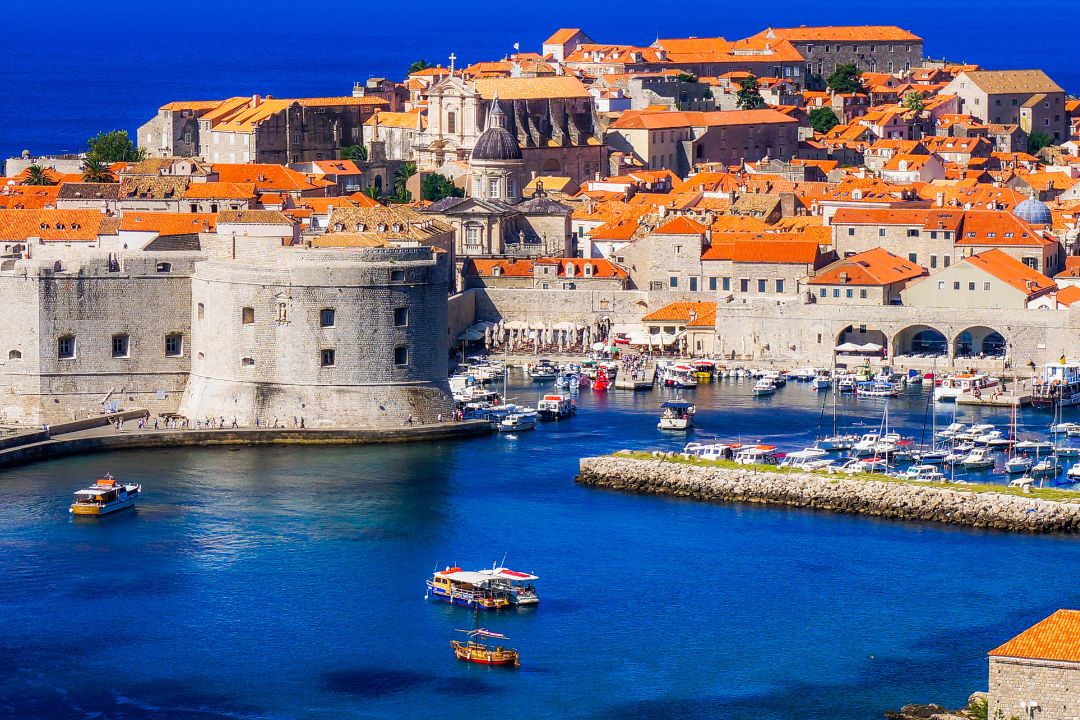Thanks to Game of Throne’s popularity, easy cruise ship access and cheap flight connections to many European cities, Dubrovnik [Google Maps location] has become Croatia’s most visited tourist destination.
The city’s fortified Old Town has become so popular that the city council introduced a crowd monitoring system. Out of interest, we had a look: A whopping 42,000 people entered through the city gates in the 24 hours before we published this article. At the same time, only 1,500 inhabitants are left within the city walls.
While we’ll write about our experience in Dubrovnik and how to best visit the city (in a sustainable way) in a separate article, today’s article is about three beautiful cities along the Dalmatian coast we recommend people visit to give Dubrovnik and its people a bit of a breather. Let’s spread the love.
Sign up to receive our email newsletter full of actionable tips and practical advice every month
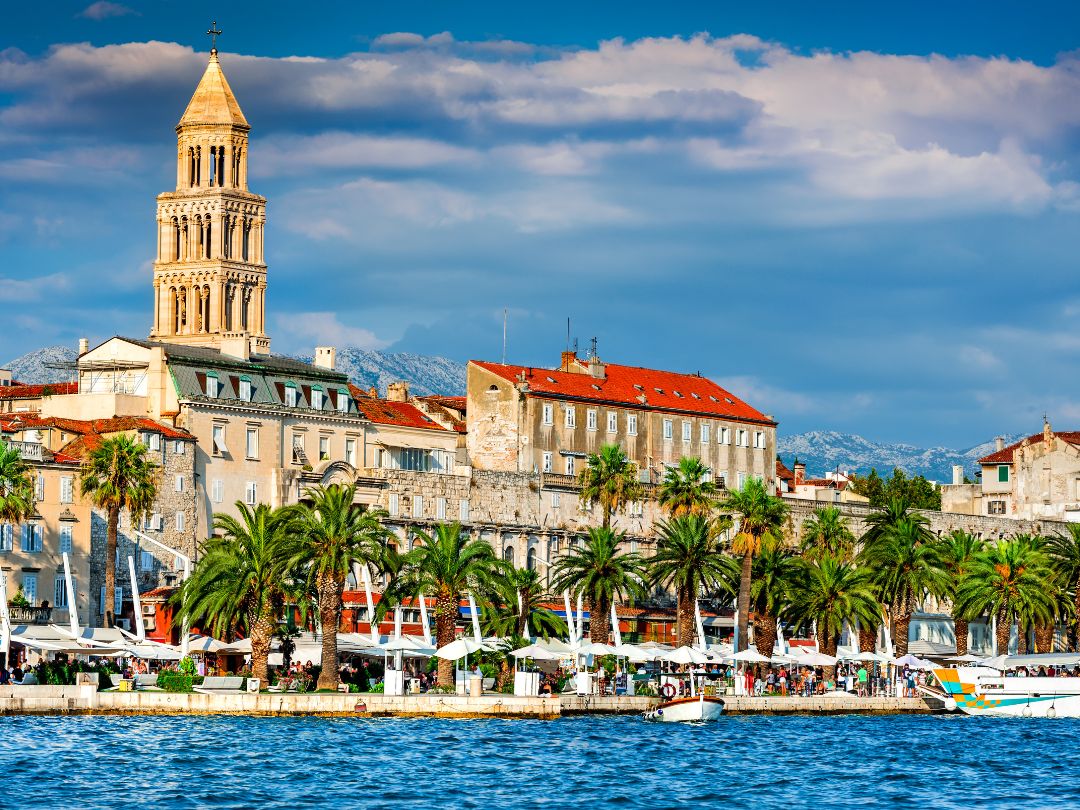
Dubrovnik is not the only city along the Dalmatian coast boasting a well-preserved Old Town
Why are these three worthy alternatives?
Our three gorgeous, less crowded and more affordable alternatives to Dubrovnik must have most of the following:
- a well-preserved and sizable Old Town (ideally with intact city walls)
- UNESCO World Heritage site/s
- a coastal location with a Mediterranean climate
- local charm with family-owned shops and restaurants
- easy access by air/sea
- easy access to offshore islands
- affordable prices.
Since we are talking about Dalmatian coastal cities which all have frequent ferry connections to their respective offshore islands, we can tick off points three and six already. We’ll check out the other five points for each city individually.
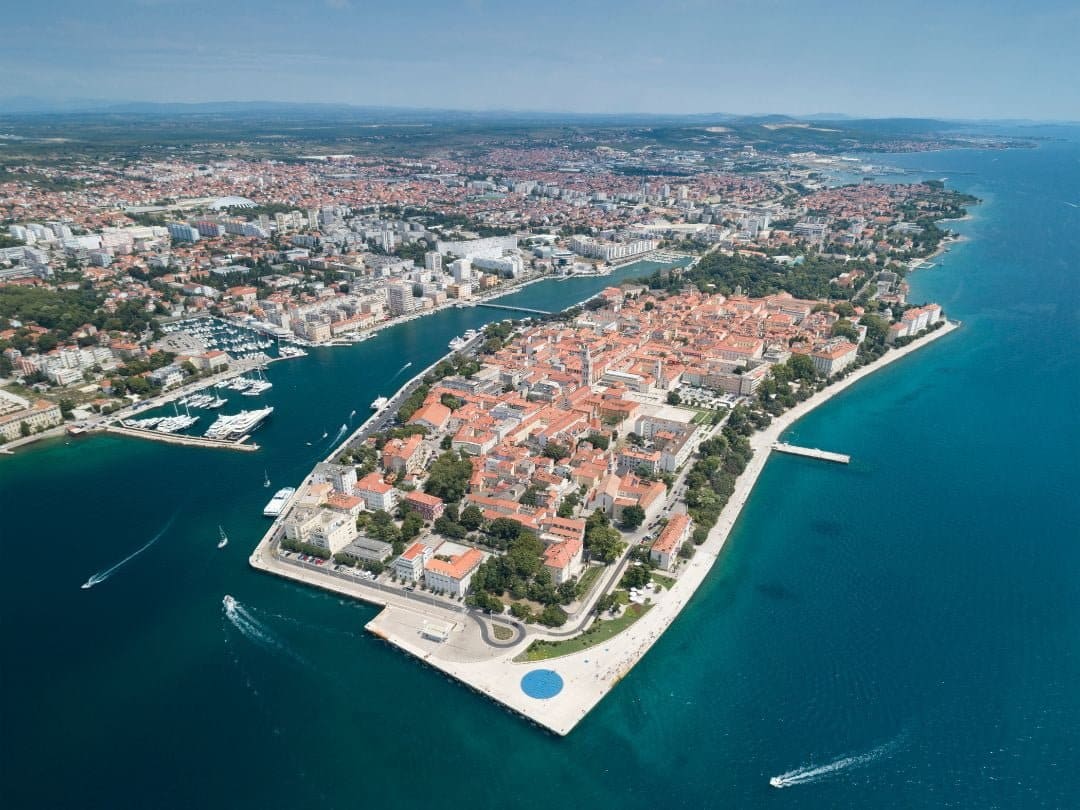
Like Dubrovnik, our three alternatives are all located along the stunning Dalmatian coast
Our suggestions are not in the order of most to least favourite. We liked them all – otherwise, we wouldn’t include them here. The order is purely a geographical one: travelling north from Dubrovnik along the Dalmatian coast.
Map of Accommodation, Points of Interest, Eateries and Transport
Below is a map of the recommended accommodation, points of interest, eateries and transport terminals/stops mentioned in this article.
Split – The city chosen by a Roman Emperor
As a setting for Game of Thrones scenes (and with a small Game of Thrones Museum [Google Maps location]) Split [Google Maps location] shares some of Dubrovnik’s fame. But thankfully, it’s not quite as busy (yet) as its smaller sibling 200-odd kilometres further down the coast.
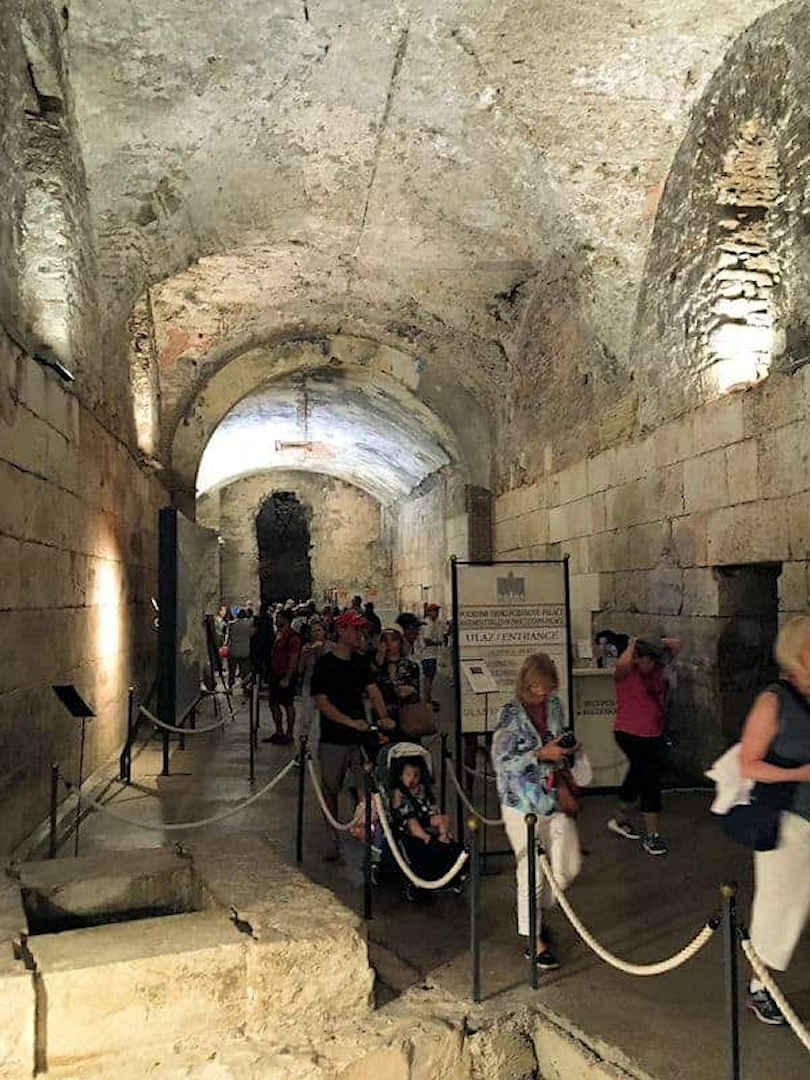
Thanks to Game of Thrones, Split shares some of Dubrovnik's fame, but it's not quite as busy (yet)
Contrary to Dubrovnik, which was founded around 614 AD, Split is over 2,200 years old.
About half of Split’s Old Town is made up of the Diocletian’s Palace [Google Maps location], which was created for the Roman Emperor over 1,700 years ago to live here during his retirement. A UNESCO world heritage site, it’s not just one big building, well it sort of is but isn’t. The rectangular structure is about 215 by 180 meters in size. Yes, you read correctly. The palace stretches over several city blocks in either direction.
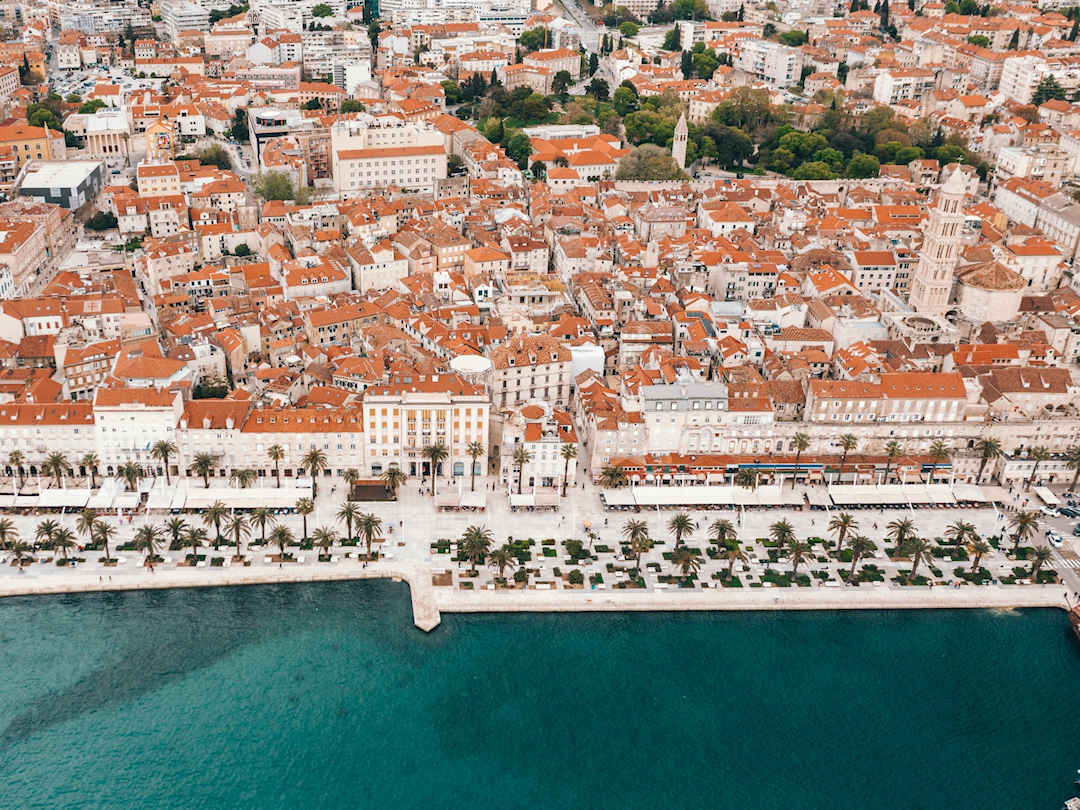
Diocletian's Palace (right) makes up half of Split's Old Town | Image coutesy of Spencer Davis on Unsplash
These days, it’s more like a city within a city, rather than a single building. Smaller (but equally impressive) palaces created during Venetian rule are lining narrow alleyways, while 3,500-year-old black granite sphinxes guard some of the original parts of Diocletian’s Palace. It’s a fascinating mix of architectural styles.
Split may not have Dubrovnik’s city walls but the Old Town is magnificent, and the palace walls are pretty impressive too. So, definite ticks for our first and second testing points.
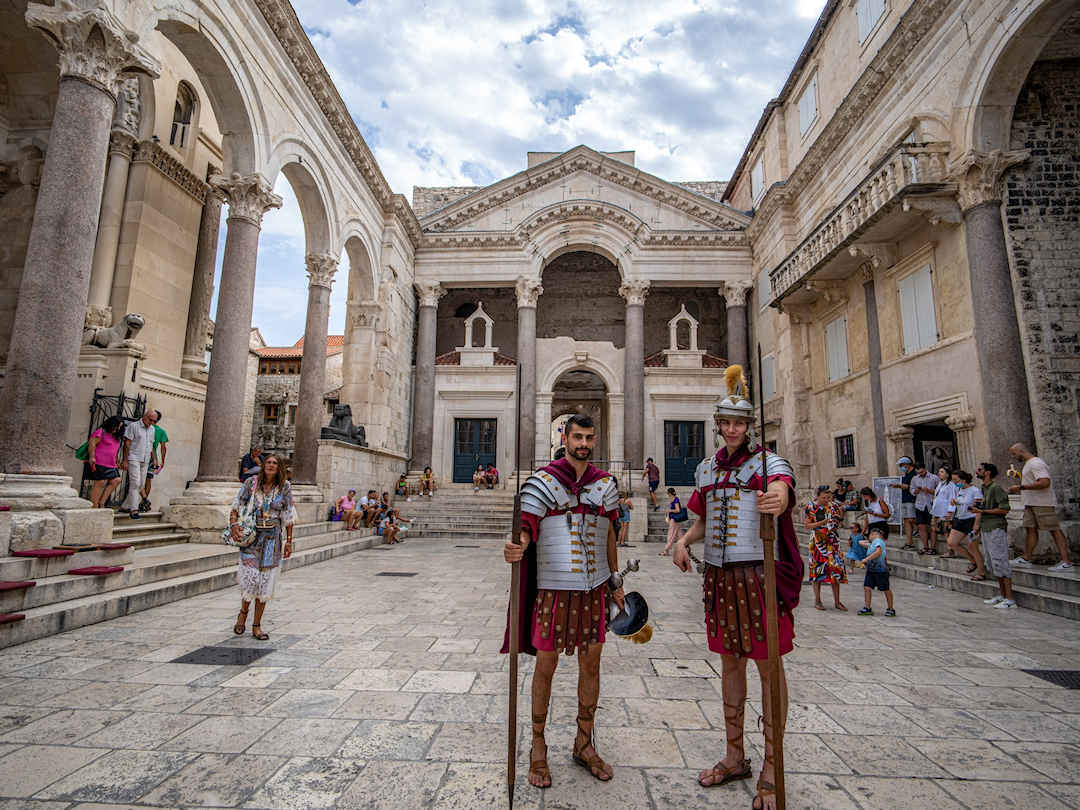
Split's Old Town has an absolutely fascinating mix of architectural styles | Image courtesy of mana5280 on Unsplash
Exploring Split’s Old Town is easily done on foot. If you like listening to the stories and anecdotes of a knowledgeable and enthusiastic local, join history professor Ana and her colleagues for a free walking tour.
If you prefer exploring Split at your own pace you can do that too:
- The Tourism Office at Peristyle Square, essentially the courtyard of Diocletian’s Palace, offers maps with a self-guided walking tour. There are also blue information plaques and frames dotted around the Old Town which explain the history of what you see.
- Another option is the self-guided tour by GPS My City.
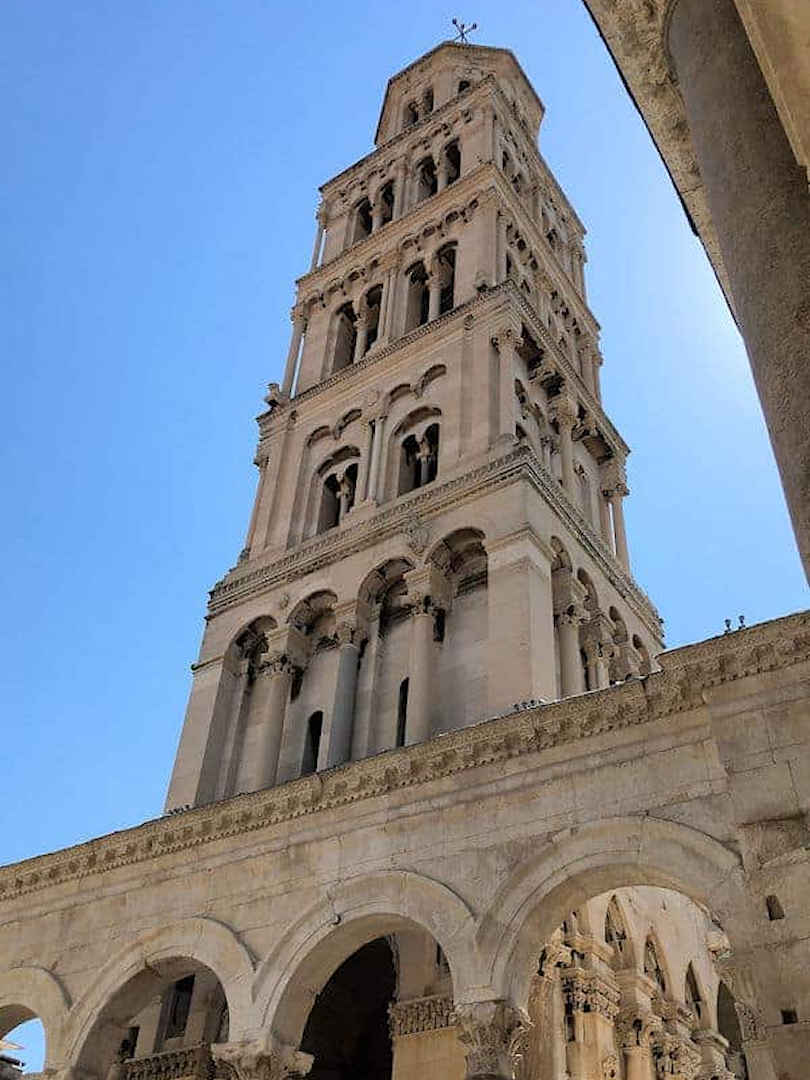
Split's Old Town is easily explored on foot - with guided tours by professionals or by yourself
When it comes to lunch or dinner time, don’t eat within the walls of Diocletian’s Palace. This is Tourist Central. Restaurants are packed, and prices are high. Venture a few side streets west from People’s Square: there are hardly any tourists and prices are sensible. For example, sharing a set lunch at Mia Fiaba, consisting of a soup, salad and mixed grill main course, cost us EUR10.
Accommodation costs in Split were the highest out of our three alternatives but still 20% cheaper than in Dubrovnik (for a similar distance from the Old Town). Ticks for testing points four and seven.
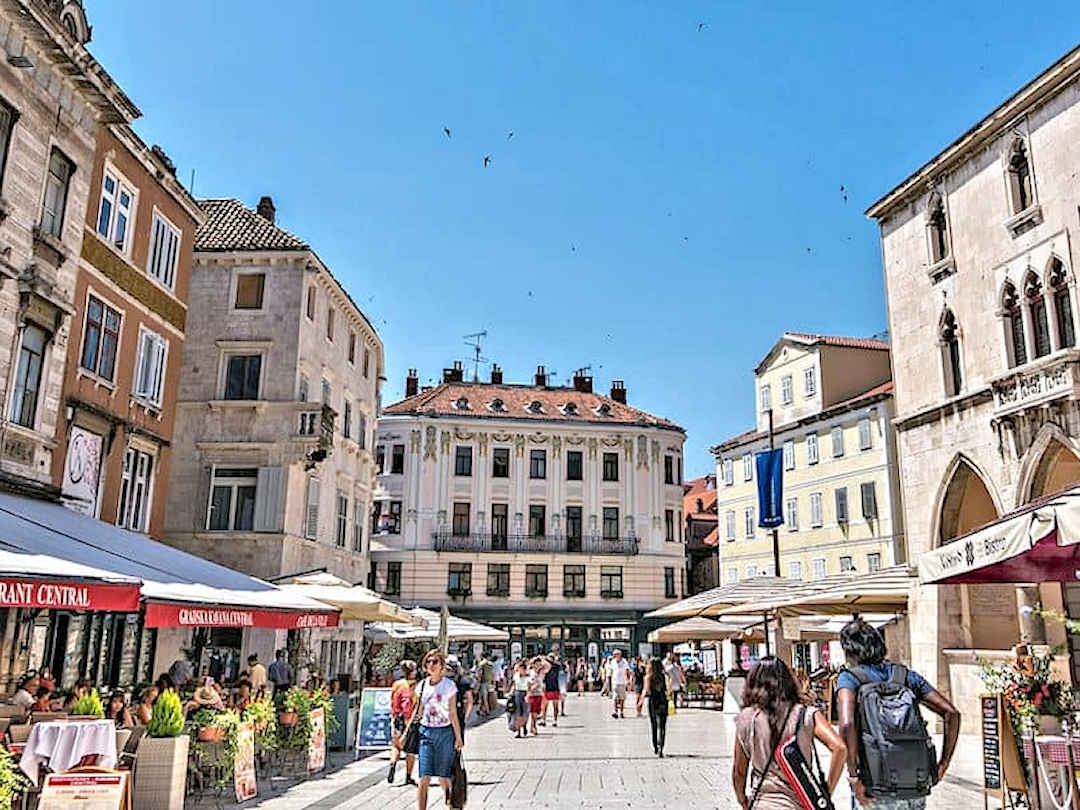
A few blocks west from here (People’s Square), there are hardly any tourists and restaurant prices are sensible
Even if you’re just transiting through Split on your way to or from the islands, make sure you stop here for a few hours. It’s worth it.
The luggage storage in the Split train station [Google Maps location] costs only HRK15 (about EUR2) for a medium-sized locker fitting two travel packs. The storage places along Obala Kneza Domagoja (the road between the bus/train station and the ferry terminal) were more expensive, and some of them were open to one side, making it easy for a passer-by to just grab a bag and disappear.

There are luggage lockers in Split's main train station, only a few hundred meters away from the Old Town
Day trips from Split
Want to see more than just Split? No worries. Great day trips from Split include the towns of Omiš [Google Maps location] – a treasure for adrenaline junkies, and Trogir [Google Maps location], another UNESCO world heritage site thanks to its beautiful Venetian architecture.
And have we mentioned the islands? Brač [Google Maps location], Hvar [Google Maps location], Vis [Google Maps location], Biševo’s Blue Cave [Google Maps location] and the Lastovo Archipelago Nature park / Park prirode Lastovsko otočje [Google Maps location] – the choice is yours.
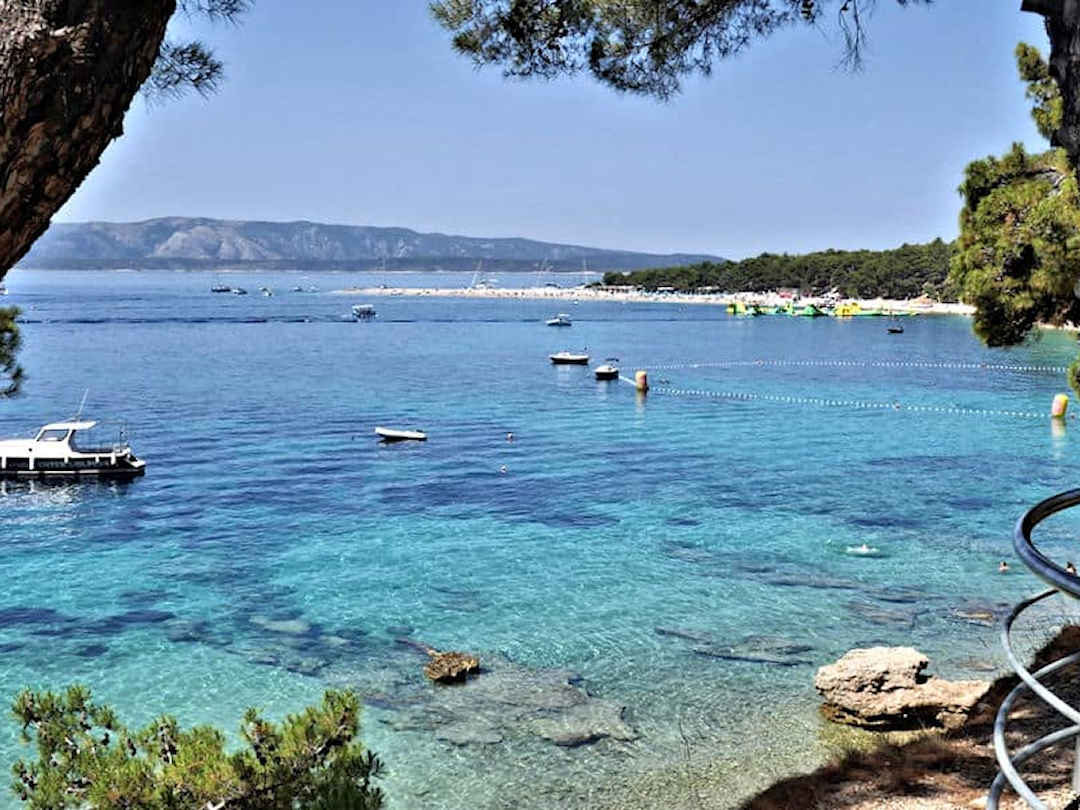
The islands of Brač, Hvar and Vis are all within easy reach from Split | Photo by Dieter G on Pixabay
How to get to Split
As for our fifth testing point: Split has an international airport [IATA code: SPU, Official website, Google Maps location], situated approximately 20 kilometres west of its Old Town, with regular flights to many European destinations.
There are frequent shuttle buses between Split Airport and Split Old Town. If you’re not in a rush, you can also take the cheaper integrated public transport service, consisting of bus number 38 between Split Airport and Kaštel Stari train station [Google Maps location], and the train between Kaštel Stari and Split’s main train station.
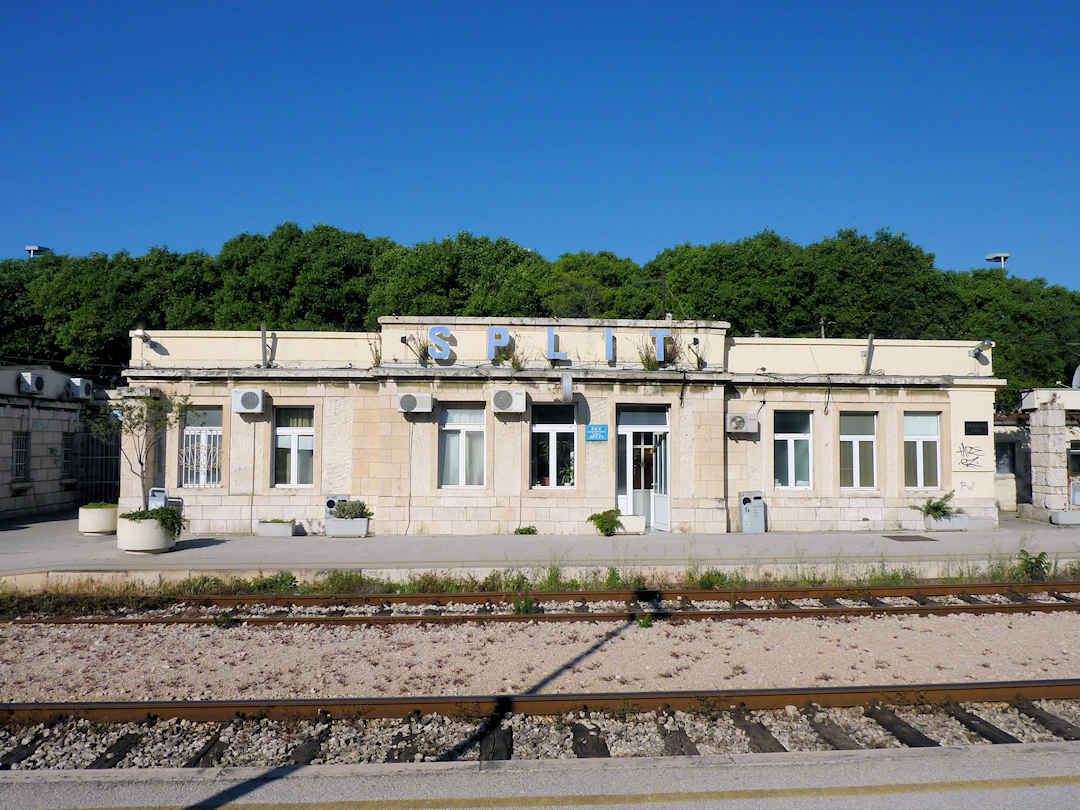
Split's airport is well-connected with the city centre - via shuttle bus or an efficient bus/train service
Šibenik – The charming city with two UNESCO sites
Situated 80 kilometres north of Split and slightly larger than Dubrovnik, is the underrated city of Šibenik [Google Map location].
We liked Šibenik – and not only because we had wonderful short-term rental hosts. While a popular summer destination, Šibenik still has a very local feel to it. Or as one of the locals put it: It’s like a big village. A definite tick for our fourth testing point.
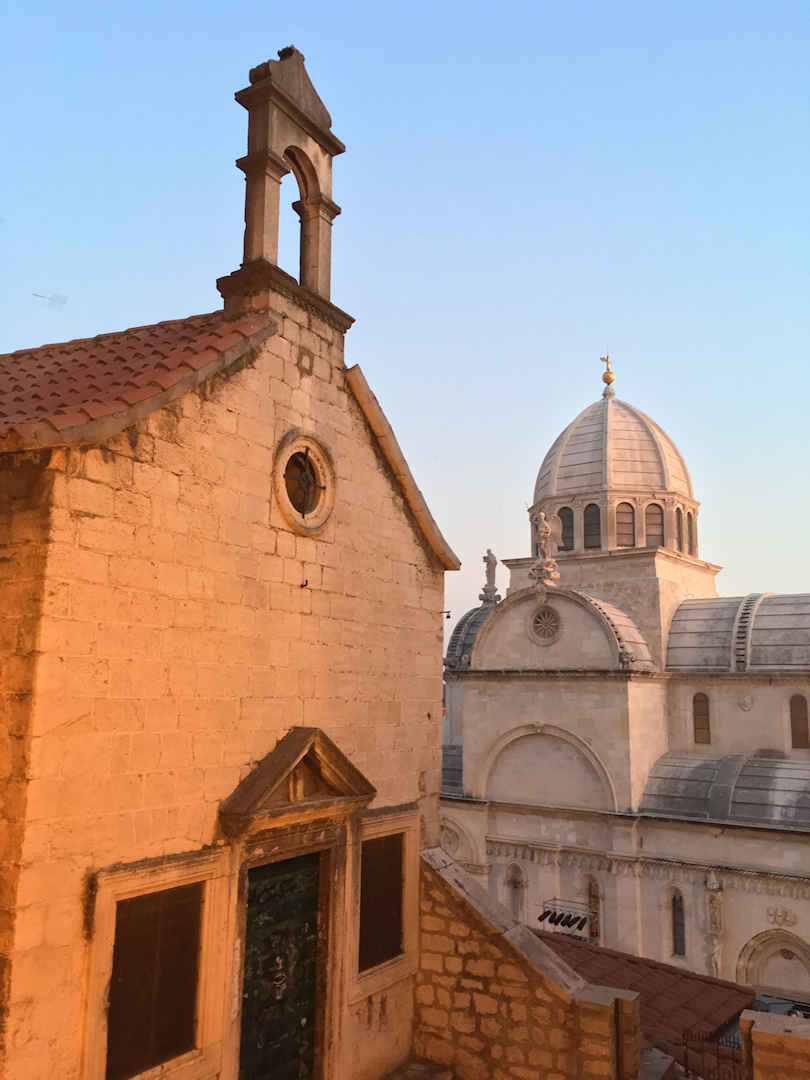
White-domed St James Cathedral is only one of two UNESCO World Heritage Sites in Šibenik
Founded in the 9th century by Southern Slavs, Šibenik is about 200 years younger than Dubrovnik. Nevertheless, the city is home to two UNESCO world heritage sites:
- the 15th-century Cathedral of St. James / Katedrala sv. Jakov [Official website, UNESCO listing, Google Maps location], in the centre of the Old Town and
- the 16th century St Nicholas Fortress [Official website, Google Maps location] which guards the entrance of the waterway that leads from the sea to Šibenik.
St Nicholas is included in the UNESCO list as part of the Venetian fortification system in the Adriatic. St Nicholas is only one of four impressive fortresses in the city. The other three – St Michael’s Fortress [Google Maps location], Barone Fortress [Google Maps location] and St John Fortress [Google Maps location] – loom high above the city, each on its own hill.
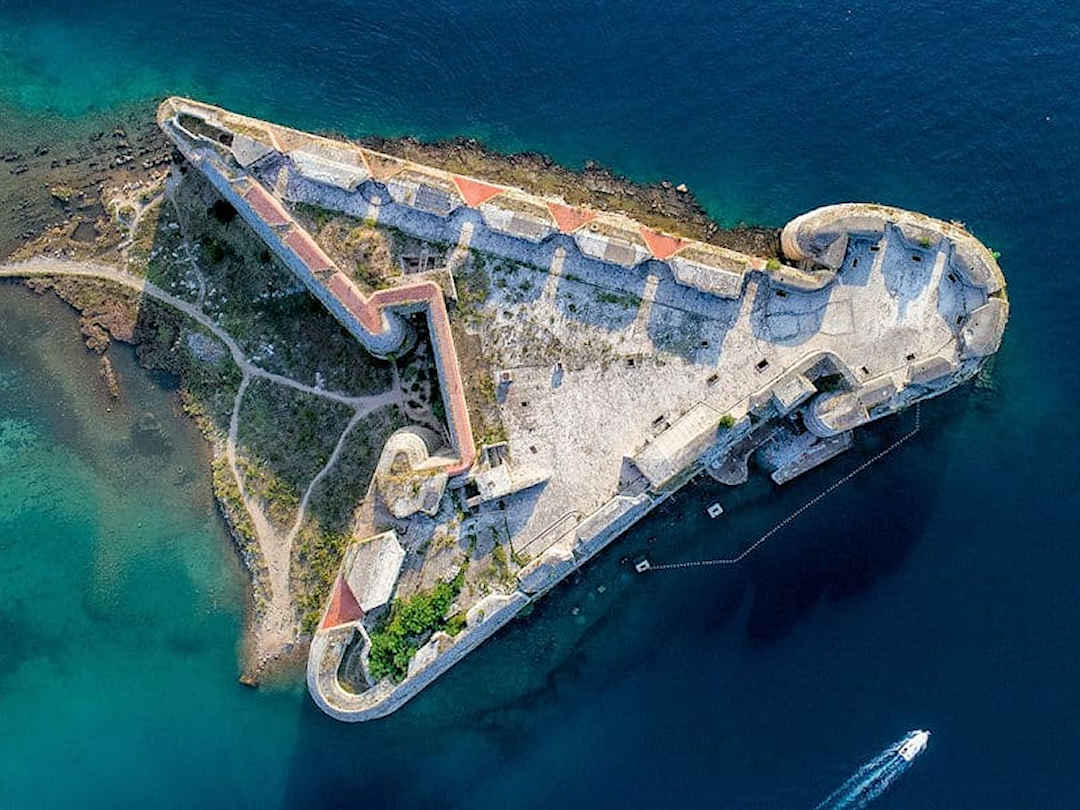
St Nicholas Fortress is Šibenik's second UNESCO World Heritage Site | Photo by Sebastian Gößl on Pixabay
A similar AR/VR approach is being taken at St Nicholas, which was opened to the public in June 2019 after years of restoration. It seems though the guardians of the fort have learned from the (over)revitalisation of St Michael and Barone, as a more empathetic approach was taken in the restoration of St Nicholas.
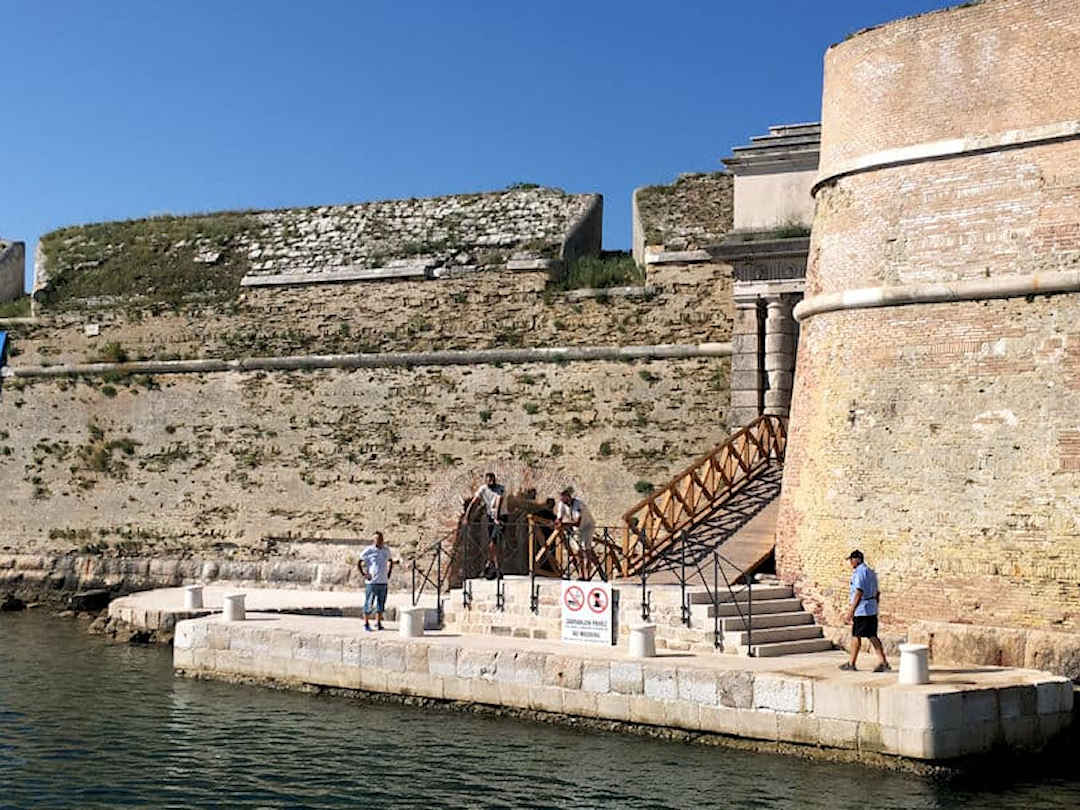
St Nicholas Fortress was only opened to the public in June 2019
Don’t get us wrong: it’s worth hiking up to the forts, even just for their magnificent (sunset) views over Šibenik and out to the islands of the Adriatic.
If you want to visit both St Michael and Barone, you can save money by buying a combined ticket (which is valid for seven days).
Want to walk (intact) city walls? You certainly can walk on top of the walls of the fortresses of St Nicholas, St Michael and Barone. Not quite like Dubrovnik’s city walls but pretty close. And with views to match (if not even more stunning).
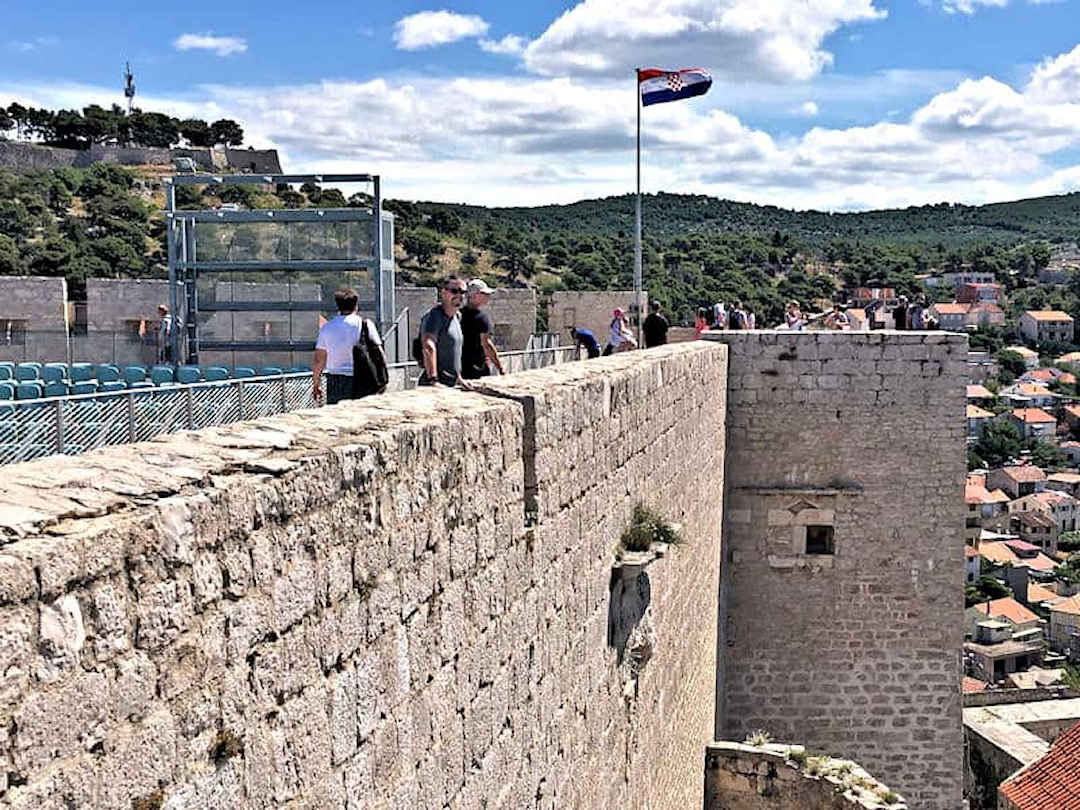
Not quite Dubrovnik's city walls but pretty impressive nevertheless are the walls of Šibenik's fortresses
The fourth of the forts, St John (located about 400 meters north-east of St Michael and 300 meters north-west of Barone), is currently undergoing renovations and can thus not be accessed. You can however easily walk from Barone up to St John, and watch the sunset from there. It’s the highest one of the three hillside forts and has the best (sunset) views in our opinion.
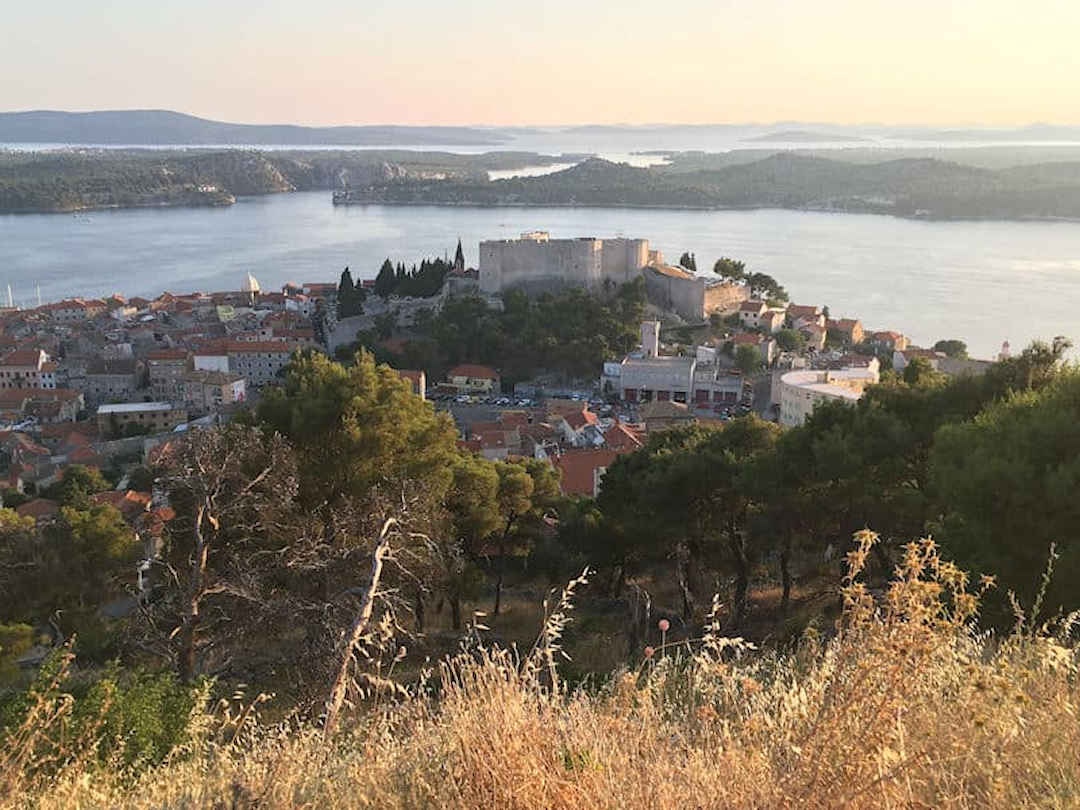
With views of St Michael's and St Nicholas Fortresses, and out to sea, St John's Fortress is a great sunset spot
To see the interior of St Nicholas Fortress you will need to join a guided tour. The tour includes a boat trip from Šibenik’s Harbour through St Anthony Channel to the fort (and return) with about an hour to explore the fortress.
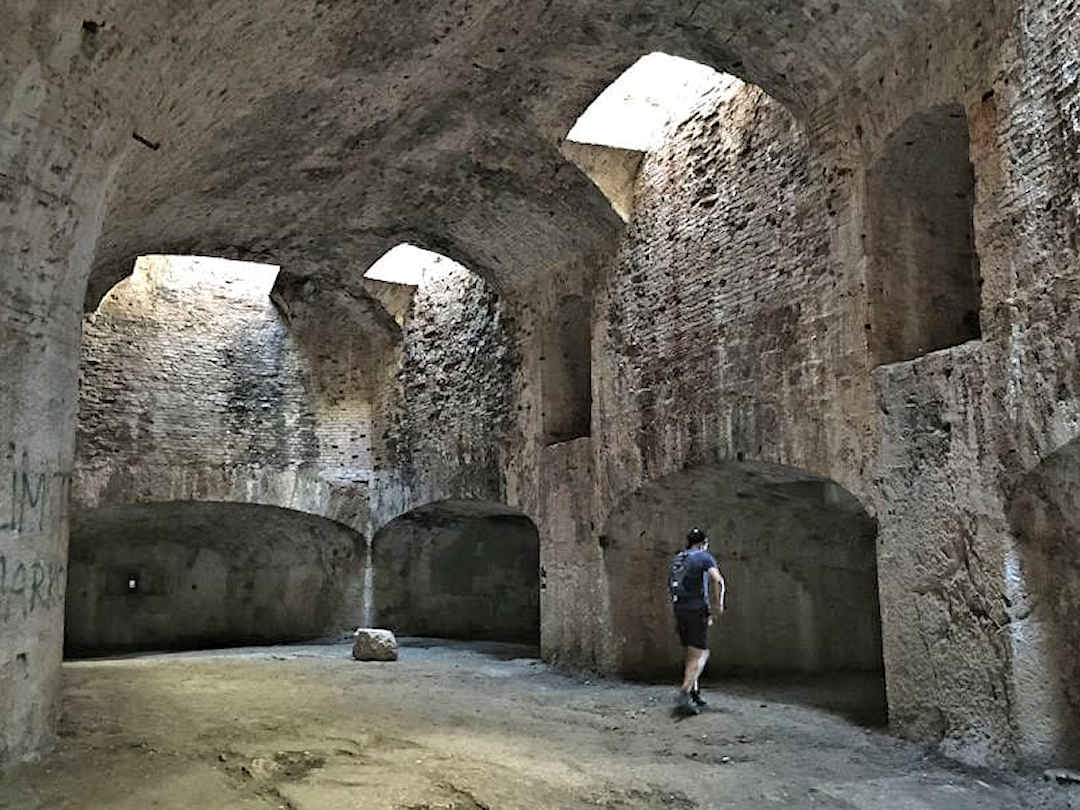
The interior of St Nicholas Fortress can only be explored on a 2 hour tour from Šibenik
Even if you don’t visit St Nicholas Fortress, St Anthony Channel is worth a visit.
Home to the remnants of cave-turned-church St Anthony’s Chruch [Google Maps location], Hitler’s Eyes (old navy tunnels used during World War Two to protect German warships from airstrikes) and old military barracks used during Yugoslav times, you can hire a bike or walk along the promenade that flanks the channel’s left side (as you look out to sea) all the way to the fortress.
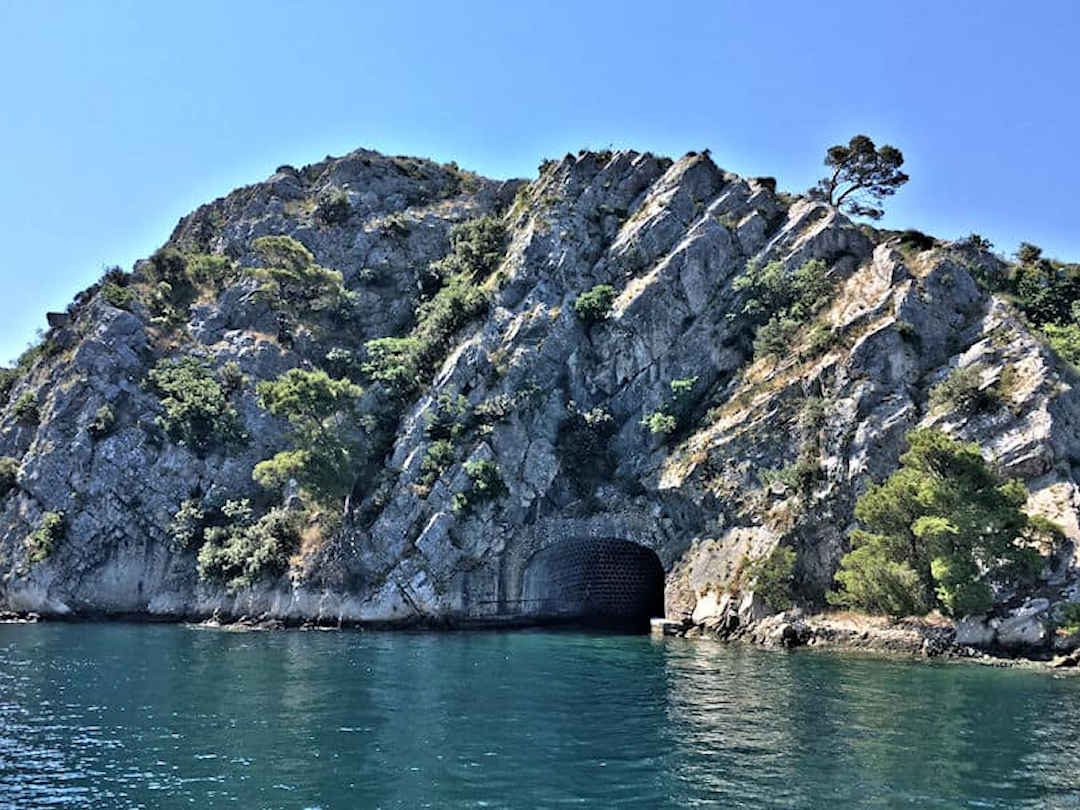
Along St Anthony Channel, there are old navy tunnels that protected Nazi warships from airstrikes, fittingly called Hitler’s Eyes
But that’s enough about the forts. Let’s talk about Šibenik’s Old Town. There are guided walking tours on offer, but it’s also super easy to explore the squares, alleyways and cobblestone stairs on your own. You never know where the next turn leads, and you’re almost guaranteed to get lost. But that’s part of the fun. Ticks for testing points one and two.
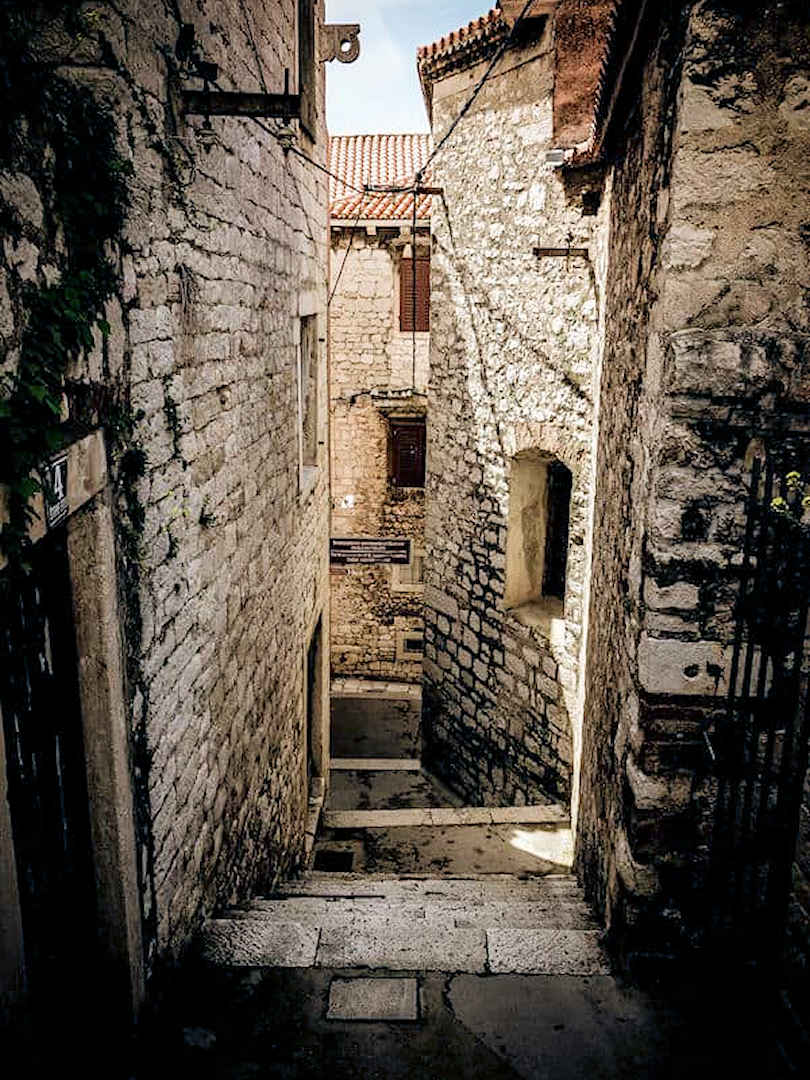
It's easy to get lost in Šibenik's Old Town, but that's part of the fun | Photo by Kevin Langlais on Unsplash
A beautiful tranquil spot to have a rest from all the exploring is the medieval St. Lawrence Church and Monastery / Srednjovjekovni samostanski mediteranski vrt Sv. Lovre [Google Maps location] (which you pass on your way up to St Michael). Prices at the garden café are very reasonable if you want to stop here to have a drink or bite to eat.
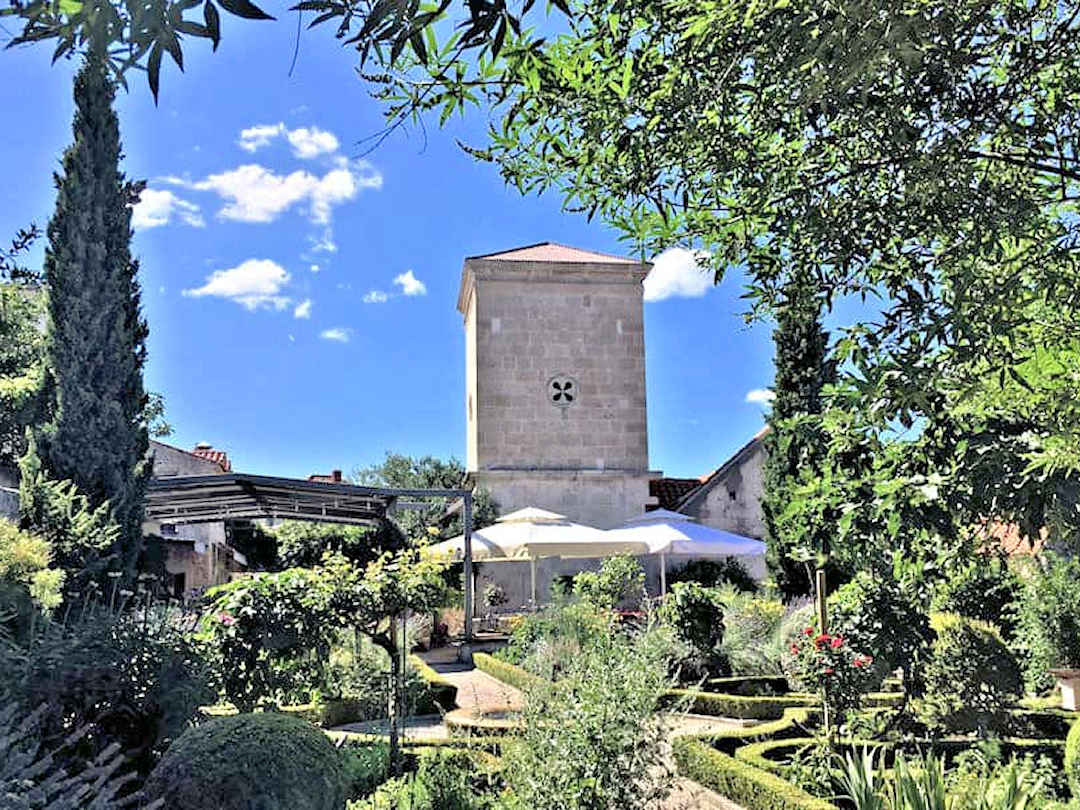
When you explore Šibenik's Old Town, make sure you stop at the medieval monastery garden of St Lawrence - it's a beautiful, tranquil spot
Speaking of food: While in the Old Town, make sure you pop by the Slastičarnica KaGrom Ice Cream shop [Google Maps location] at Trg Kralja Držislava. They serve hands-down the best gelato in the world (sorry Italy).

Šibenik has the world's best gelato, at Ka Grom Ice Cream Shop
Just outside the Old Town, wedged between Stankovačka and Starčevića Ulica, is Šibenik’s produce market [Goolge Maps location]. Locals go here early in the morning to stock up on fruit, vegetables, meat and seafood.
Šibenik Tourist Information Centre
The Šibenik Tourist Information Centre [Google Maps location], Telephone Phone: +385 (22) 214 411 or +385 (22) 214 448, [email protected] is a great place to check out as they can also offer suggestions on what to see and do.
If you rather have someone else cook for you, head to Šimun [Google Maps location]. This unassuming little restaurant (open Monday to Saturday) serving traditional Balkan cuisine at very reasonable prices, was recommended to us by our host, and it didn’t disappoint.
Speaking of affordability: Our accommodation in Sibenik, a few blocks away from the Old Town, was 30 per cent of what we paid in Lapad, 3km away from Dubrovnik’s Old Town. This is a definite tick for our seventh testing point.
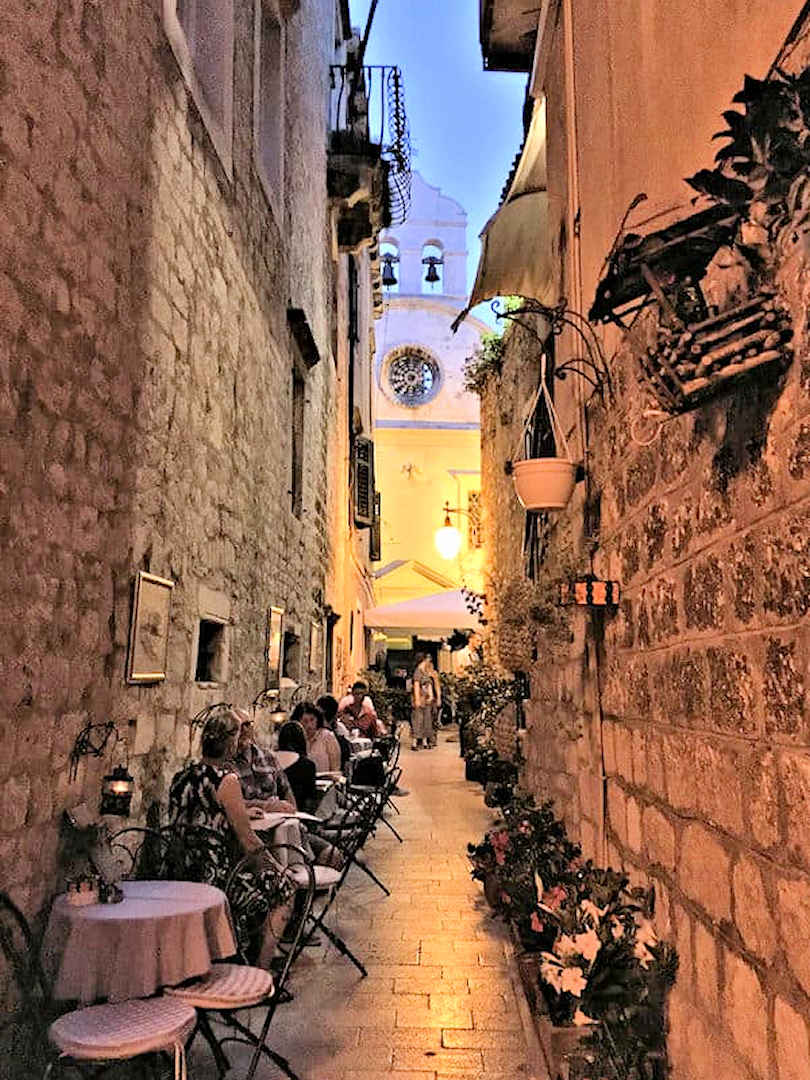
Our studio 10 minutes' walk from Šibenik’s Old Town cost us 2/3 of what we paid for our stay 3km away from Dubrovnik's Old Town
Day trips from Šibenik
If Šibenik is not enough to keep you occupied for days, head to Primošten [Google Maps location]. A 40 minutes drive south of Šibenik, Primošten’s Old Town is situated on an island, complete with cobble-stoned streets that just invite you to wander. Plus, if it’s a hot day, Primošten is known for its gorgeous beaches. So, don’t forget your swimsuits.
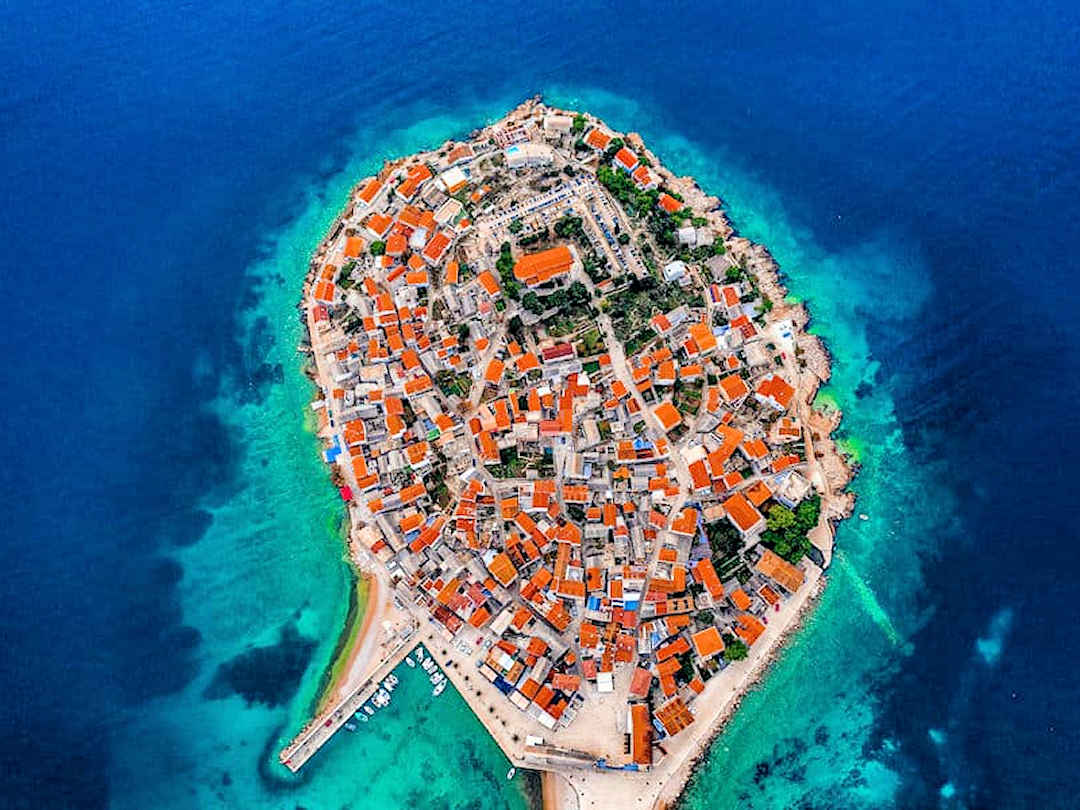
Beautiful Primošten makes for a great day trip from Šibenik | Photo by Hrvoje Klaric on Unsplash
Šibenik is also the gateway to Krka National Park (approximately 20 kilometres north of Šibenik’s Old Town) and the laid-back, (largely) traffic-free and less touristy islands of Krapanj, Kaprije, Prvić, Žirje and Zlarin, a few kilometres offshore.
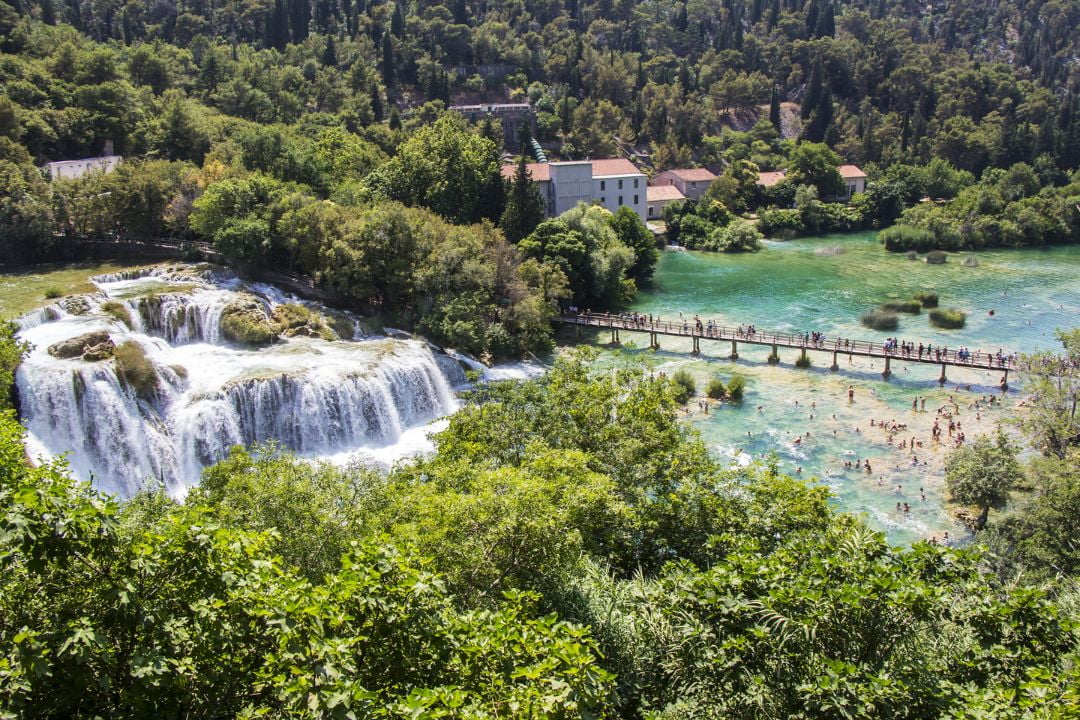
From Šibenik, it's an easy 20km drive/bus ride to Krka National Park
How to get to Šibenik
As for our fifth testing point: Šibenik conveniently sits between two international airports. Split Airport ( is the closest, approximately 50 kilometres to the southeast. Zadar Airport (Official website, IATA code: ZAD, Google Maps location) is approximately 80 kilometres to the northwest of Šibenik.
Don’t worry: you don’t need to hire a car to travel between the airport/s and Šibenik:
- There are frequent bus connections between Zadar Airport and Šibenik
- From Split Airport, you can take the number 37 bus to Trogir and another bus from there to Šibenik (and vice versa).
- In July and August, there are also shuttle buses between both Zadar and Split Airports and Šibenik.
Zadar – The once largest fortified city in Dalmatia
Our third alternative to Dubrovnik, the ancient city of Zadar [Google Maps location], is situated 75 kilometres north of Šibenik.
Similar to Split, Zadar’s Old Town is located on a peninsula. Similar to Dubrovnik, it managed to retain (some of) its city walls. Though dating back to the 4th century BC, Zadar is about 1,000 years older than Dubrovnik.
Similar to Šibenik, Zadar avoided Ottoman rule thanks to significant fortifications, which made Zadar the largest fortified city in Dalmatia in the middle of the 16th century. Together with Šibenik’s St Nicholas Fortress, the fortified city of Kotor and other fortifications on the Western side of the Adriatic, Zadar’s defensive system is included in the list of UNESCO World Heritage Sites.
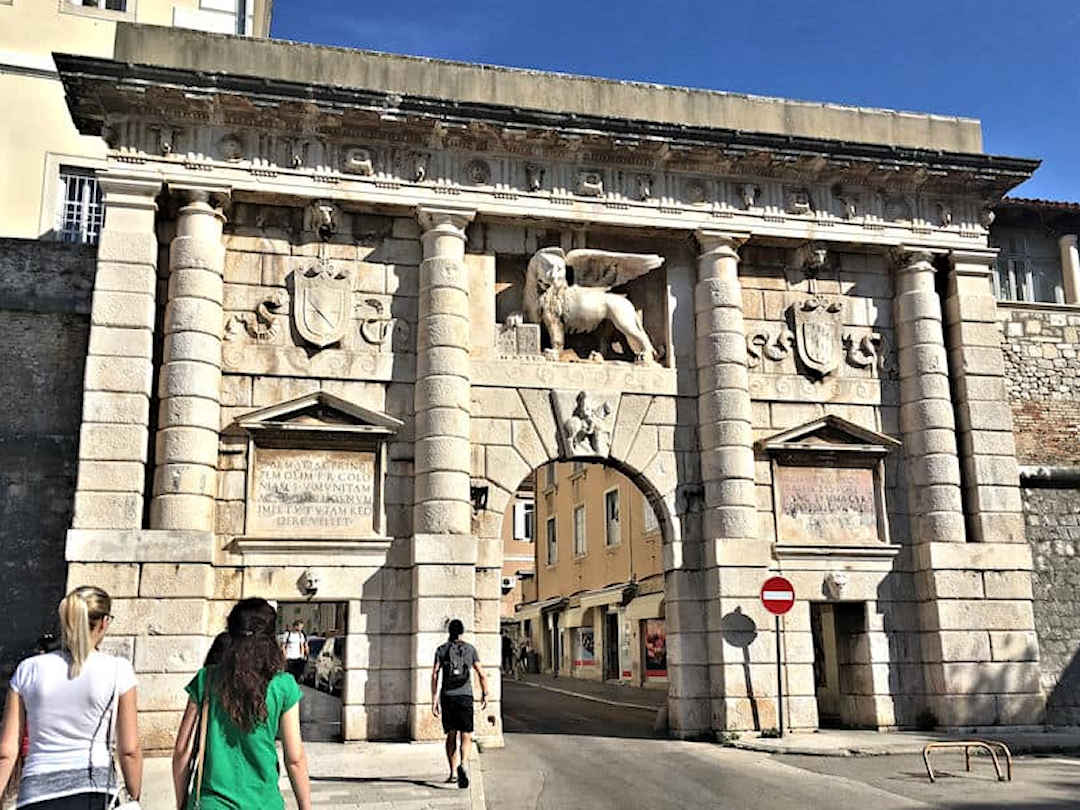
The Venetian Land Gate is part of Zadar's UNESCO World Heritage Site
Unfortunately, a large part of this magnificent city was destroyed by Allied bombings during World War Two. What is left (and has been restored) however, is worth a visit.
Take the Roman Forum for example: Laying partially buried under the Byzantine Church of St Donatus / Crkva sv. Donata [Google Maps location] and St Anastasia’s Cathedral / Prvostolnica sv. Stošija (Anastazija) [Google Maps location], you can vividly imagine life here back in Roman times. There are even altars which were used for blood sacrifices during Roman times and a Roman column which was used to publicly humiliate wrong-doers in the Middle Ages.
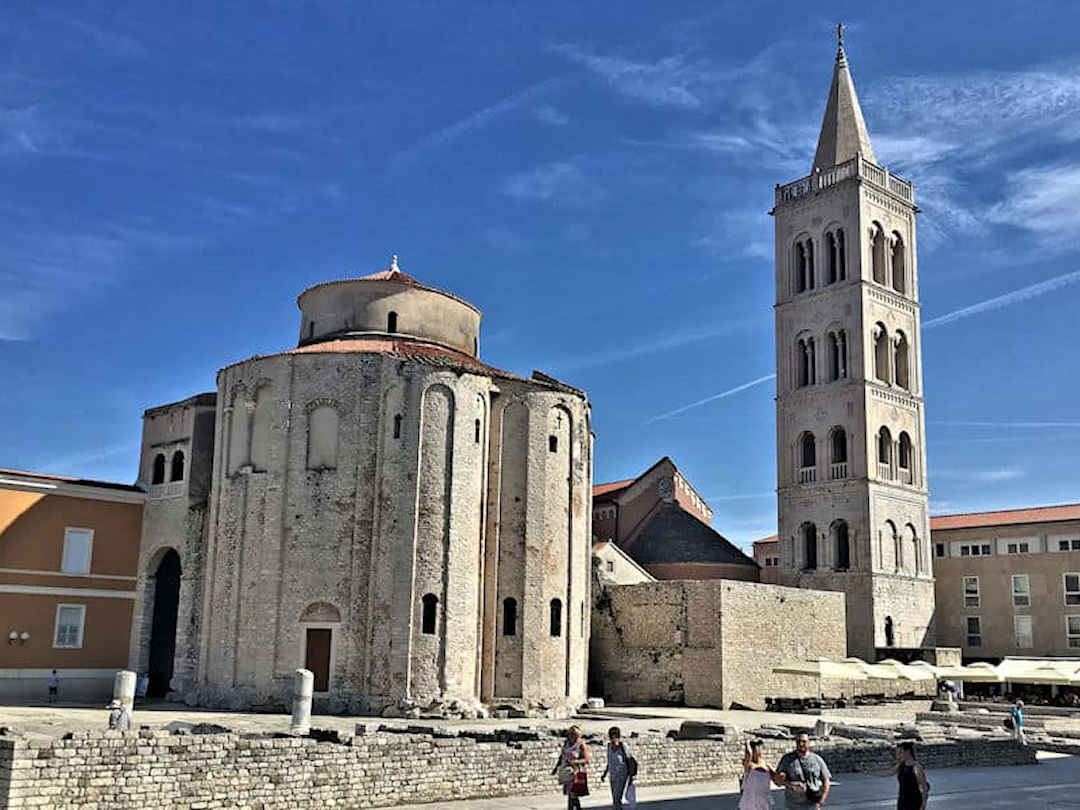
Zadar's Roman Forum lays partially buried under the Byzantine Church of St Donatus and St Anastasia’s Cathedral
Zadar’s Old Town is very compact and easily explored on foot. If you’re looking for a self-guided walking tour: fellow Kiwi travel bloggers Terry and Maura of Travel Kiwis have put together an easy-to-follow 3.3km loop that covers all the important sites.
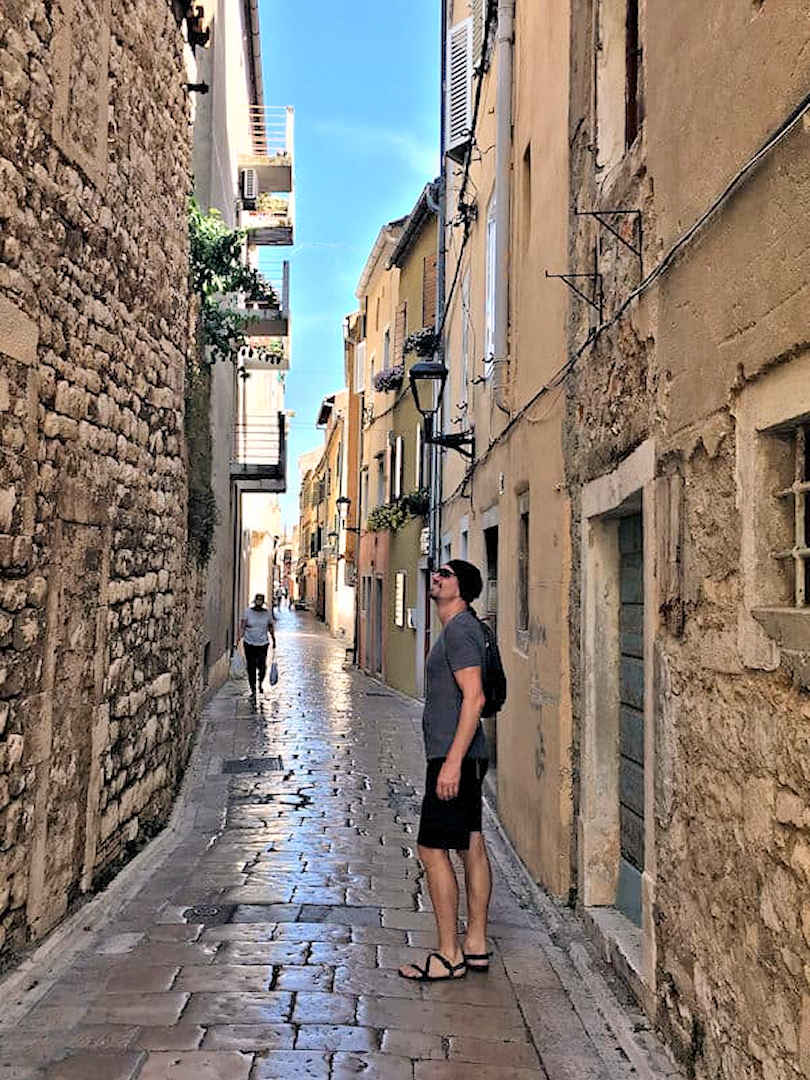
Explore Zadar’s Old Town on a (self-)guided walking tour
Like Šibenik, Zadar has a small but excellent Market Zadar / Tržnica Zadar [Google Maps location] just inside the city walls (the fish market hall is part of the city walls).
If you prefer to dine out, even the restaurants in the Old Town and/or with sunset views won’t burn a hole into your wallet.
Our accommodation in Zadar, a mere 10 minutes walk from the Old Town, was 30 per cent of what we paid in Lapad, 3km away from Dubrovnik’s Old Town. That’s also a tick for our seventh testing point.
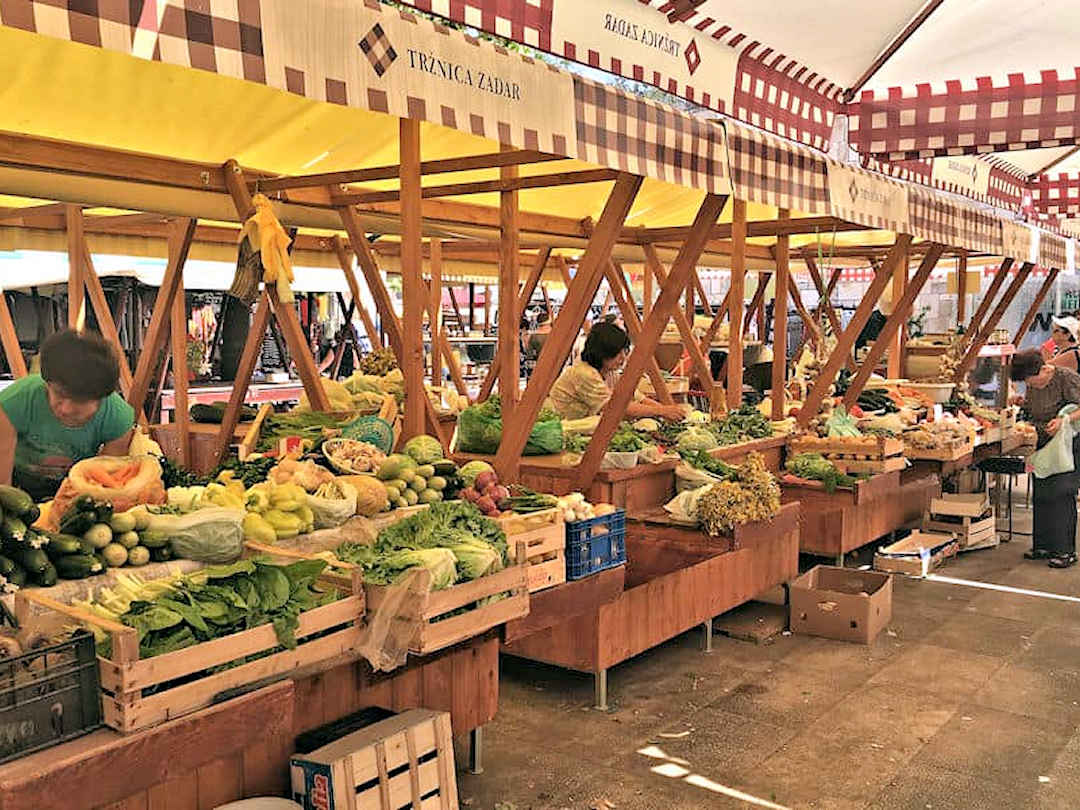
Zadar has a small but excellent produce market just inside the city walls
Zadar Tourist Information Centre
The Zadar Tourist Information Centre [Google Maps location], Telephone Phone: +385 23 316 166, [email protected] is a great place to check out as they can also offer suggestions on what to see and do.
While Šibenik‘s best sunset spots are its fortified hills, Zadar’s are
- the Sea Organ / Morske orgulje [Atlas Obscura, Google Maps location] (after all, where do you get to enjoy your sunset with melodies created by the waves of the ocean?) and
- the bell tower of St Anastasia’s Cathedral [Google Maps location].
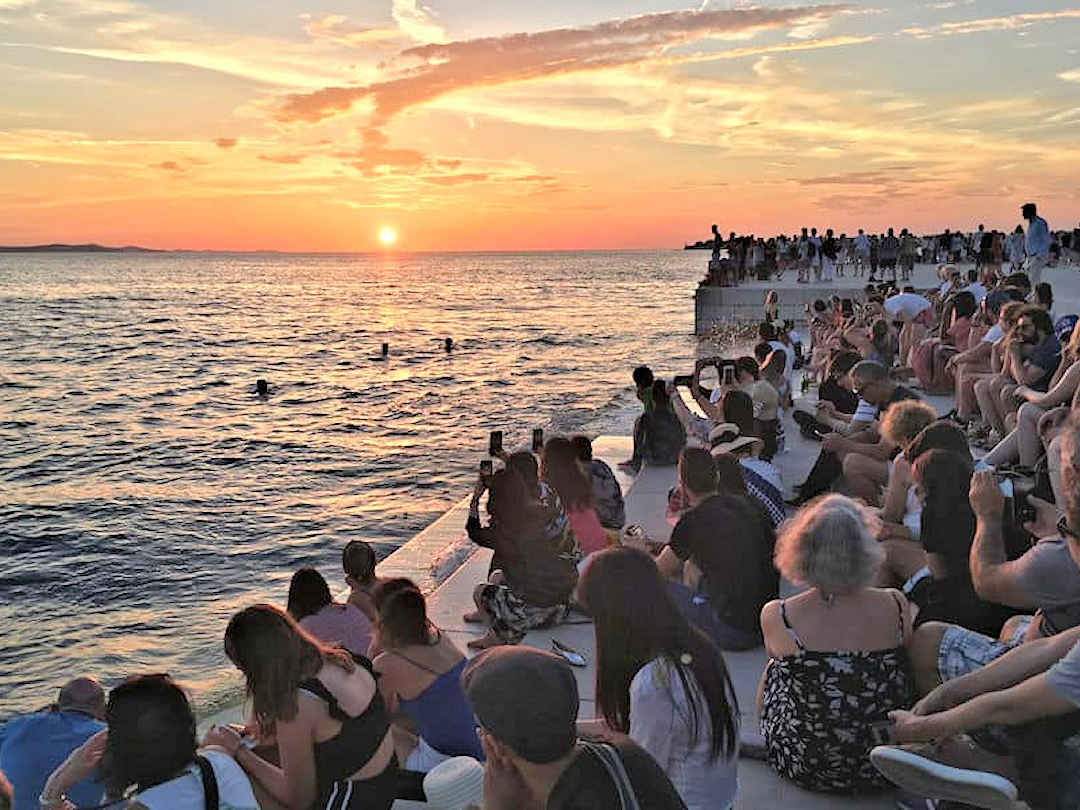
Zadar's Sea Organ, where you get to enjoy your sunset with the melodies of the Adriatic
Day trips from Zadar
For a different experience, you can jump on a ferry to the beaches of Preko [Google Maps location], or join day tours to the Kornati National Park / Nacionalni Park Kornati [Google Maps location] and Telascica National Parks [Google Maps location] or Dugi Otok [Google Maps location].
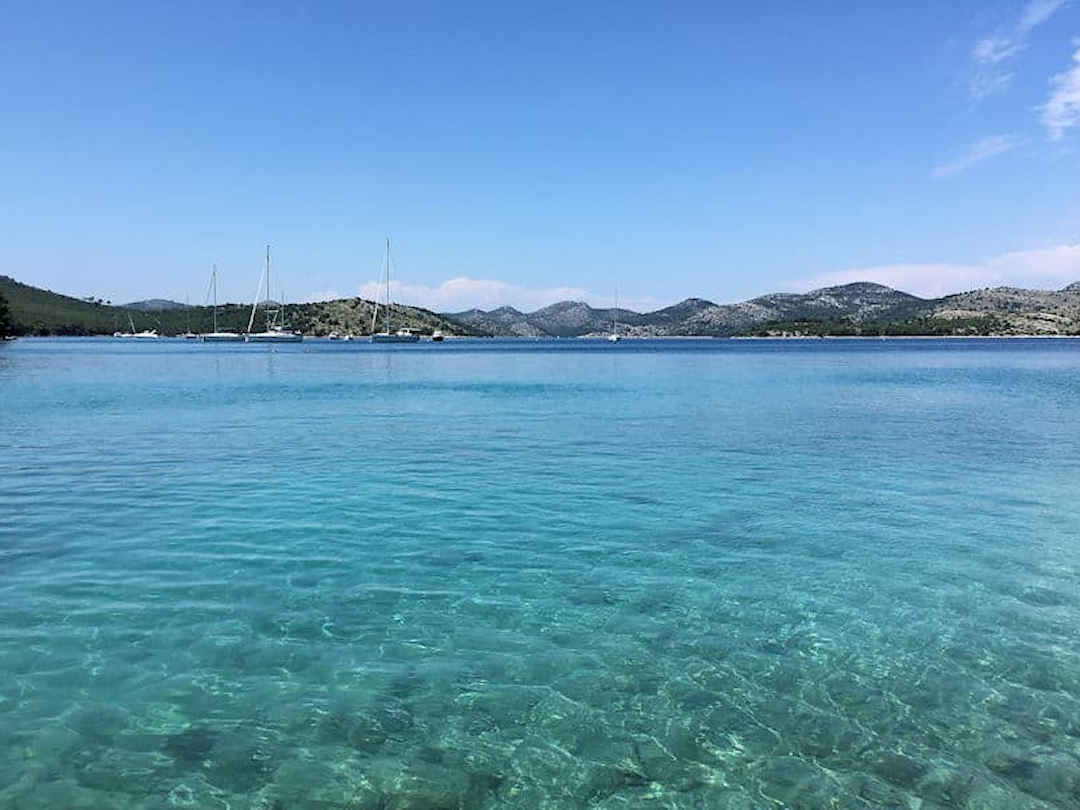
The Kornati Islands and Telascica National Park make fore a great day trip from Zadar
How to get to Zadar
Zadar has an international airport (Official website, IATA code: ZAD, Google Maps location), situated approximately 10 kilometres east of Zadar’s Old Town.
There are regular flights from/to many European countries and frequent bus services between the airport and the city centre. That ticks on all fronts for Zadar too.
Are you planning to visit Split, Sibenik or Zadar and have any questions we didn’t answer?
I wrote this Dubrovnik alternatives travel guide based on my own experience. If you have been to Split, Sibenik or Zadar as well and you have something to add to this list of sustainable amd affordable things to do, please feel free to contact me. If you liked my tips and found them helpful, I would appreciate if you could share them with your friends and family via the Share buttons below. Even better, link to the page from your personal blog or social media platforms.

